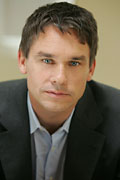Marcus Buckingham knows enough about good management to know he’s not a good manager.
Before launching a career as a management consultant and author of such books as First, Break All The Rules: What the World’s Greatest Managers Do Differently and The One Thing You Need to Know…About Great Managing, Great Leading and Sustained Individual Success, Buckingham served as head of The Gallup Organization’s strengths management practice. He was a manager, and he didn’t much care for it. “I wasn’t terrible, but I had no appetite for it,” said Buckingham, who spoke about management and leadership at the Wharton Leadership Conference on June 9. The conference was sponsored by Wharton’s Center for Leadership and Change Management and Center for Human Resources.
According to Buckingham, the best managers share one talent — the ability to find, and then capitalize upon, their employees’ unique traits. “The guiding principle is, ‘How can I take this person’s talent and turn it into performance?’ That’s the only way success is possible.” And yet not everyone has that knack, Buckingham said. If he has learned anything from his years spent interviewing the best minds of the business world, it is this: Truly great managers, and truly inspiring business leaders, are rarer than many think. “Some of you in this room may not have that talent,” he said. “If not, management can become a thankless task.”
Checkers vs. Chess
How to tell a good manager from a bad manager? According to Buckingham, it’s simple: Bad managers play checkers. Good managers play chess. The good manager knows that not all employees work the same way. They know if they are to achieve success, they must put their employees in a position where they will be able to use their strengths. “Great managers know they don’t have 10 salespeople working for them. They know they have 10 individuals working for them …. A great manager is brilliant at spotting the unique differences that separate each person and then capitalizing on them.”
It may sound elementary, but a quick glance around the business world indicates that many companies have yet to grasp this simple concept of putting people’s strengths to use, Buckingham said. That’s because the business world — and the world at large — is obsessed with weaknesses and finding ways to fix them. Buckingham cited a recent poll that asked workers whether they felt they could achieve more success through improving on their weaknesses or building on their strengths. Fifty-nine percent picked the former.
“A great manager sees the folly in this,” said Buckingham, who has interviewed some of the business world’s most successful leaders for his books. “A great manager knows he or she will get the most return on investment by working on strengths.” Buckingham has seen this management style work. He just doesn’t see it often enough, and he believes too many workers spend too much of their time doing things they don’t like to do or simply aren’t good at doing.
Buckingham co-authored his book, Now, Discover Your Strengths, in hopes of kick-starting a management revolution that will push mangers to focus on strength. In the book, Buckingham and co-author Donald O. Clifton describe 34 distinct worker profiles — “Learner,” “Achiever” and “Developer,” among others — and offer advice on how those personalities can best be put to use. “Most people are not using their talent at work at all,” Buckingham said.
So how can managers tap into the talent they have in their organizations? Buckingham said a good first step is to determine what employees are good at. The tasks they learn quickly, the talents they naturally exhibit and the jobs they feel good about doing are hints about their inherent strengths. Once those strengths are uncovered, a good manager will put them to use. “You can only win as a company when you get your people into positive numbers,” Buckingham said.
Optimism and Ego
Managing employees successfully is a rare talent. Even rarer, Buckingham said, is the ability to lead. And all good managers are not necessarily good leaders.
“I do think there is a rather keen and distinct difference between managing and leading,” Buckingham said. The chief responsibility of a leader, for example, “is to rally people for a better future. If you are a leader, you better be unflinchingly, unfailingly optimistic. No matter how bleak his or her mood, nothing can undermine a leader’s belief that things can get better, and must get better. I believe you either bring this to the table or you don’t.”
Along with that optimism, great leaders can also bring big egos — and that’s not a bad thing. While some have blamed the business world’s recent string of scandals — Enron, WorldCom and others — on bloated executive egos, Buckingham disagrees. It’s not ego that ruined Ken Lay, but rather a lack of ethics. There’s a big difference, Buckingham said. And considering the responsibility facing business leaders to build a future for their companies, a big ego might be what is needed.
“If you are going to lead, you better have a deep-seated belief that you should be at the helm, dragging everyone into that better future,” he said. “Virtually nothing about a leader is humble. I’m not saying they are arrogant, but their claims are big.” Buckingham said successful leaders must find a “universal truth” to rally their followers. These universal truths stem from the basic human needs, fears and desires that unite all people, across all cultures. They also happen to be great tools for leadership.
Take, for example, one of the great human fears — fear of the future. “We all share a fear of the unknown,” Buckingham said. “The problem for the modern-day leader, of course, is that you traffic in the future.” Buckingham says some the best leaders can overcome this fear — and build confidence among their followers — with a weapon of their own: clarity.
By presenting a clear message, and backing up their message with actions that support it, top managers of such companies as Tesco, Best Buy and Wal-Mart have rallied employees to their cause and enjoyed bottom-line success as a result, Buckingham noted. “The best way to turn anxiety into confidence is this: Be clear. Clarity is the antidote to anxiety. If you do nothing else as a leader, be clear.” Former New York City Mayor Giuliani provided a good example of effective leadership through clarity, Buckingham said. When Giuliani took office in 1993, he could have turned his attentions just about anywhere; America’s largest city certainly had its share of problems.
But Giuliani set one specific, clear and focused goal for his administration. He would reduce crime and improve quality of life for residents. Then he laid out three simple ways he was going to start making that happen: He announced he would get rid of the window washers who pestered New York City drivers; clean subways of graffiti and then keep the vandals away; and make all cab drivers wear collared shirts. The issues were, on their surface, minor. But they were relevant to his citizens. And by setting three immediate goals — and then achieving them — Giuliani was able to build trust among residents and respect among his workers. That trust carried over as he tackled larger challenges, and within a few years of his arrival, the FBI named New York the safest big city in America. “You can do a lot worse than pick just a few areas you want to take action on right now,” Buckingham said.
Clarity of purpose has also been a driving factor in the success of Tesco, the British food giant that has more than 2,000 stores and 360,000 employees worldwide. When Terry Leahy took over as CEO in 1997, he decreed the company’s focus would be, from that point forward, to serve the housewives of the world. Then he went out and did something to prove he believed in his focus: He added more checkout lines in all his stores, a move that led to significantly higher labor costs but also won over his customers and sent a message to his employees that they were there, as Leahy had proclaimed, to provide courteous, efficient service.
“That kind of clarity builds confidence in people,” Buckingham said. Today, Tesco is one of the three largest retailers in the world, and Leahy’s success provides a handy leadership lesson. “When you want to lead, start with the future.” Buckingham said. “Get specific. And get vivid.”



